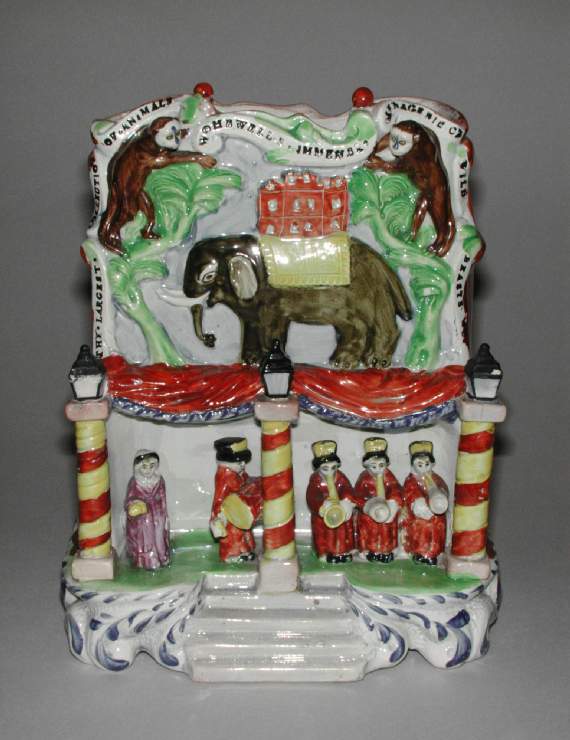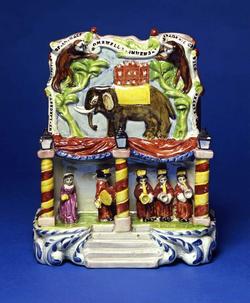Current Location: Gallery 27 (Glaisher)
Titles
Wombwell's Menagerie
Maker(s)
Production:
Unidentified Pottery
Entities
Categories
Description
Earthenware figure group, moulded and modelled, pearlware glazed and painted with polychrome enamels.
Staffordshire figure group representing Wombwell’s Menagerie on the front of a wide spill vase, standing on a blue and white scrolled base. Steps lead up to a stage on which three men are blowing trumpets, one beats a drum and a woman is seated. The stage is framed by yellow and red candy striped columns, with another in the centre, each topped by a lamp, between which red curtains are gathered up. Above is a moulded panel with an elephant, bearing a castle on its back, between two trees; on each tree is a monkey in high relief. Round the panel, on a ribbon, runs the inscription THE . LARGEST . COLLECTION. OF. ANIMALS .WOMBELL’S. IMMENSE. MENAGERIE. OF. WILD. BEATS. ETC. The back is flat, glazed and unpainted. The underside is flat and glazed, with two pad feet at the back corners ; the scrolls form feet at the front.
Notes
History note: Captain Reynolds Collection, London; sold to Messrs Gill and Reigate; Mr Stoner, London, from whom purchased in 1910 by Dr J.W.L. Glaisher, FRS, Trinity College, Cambridge. Dr Glaisher paid £125 for this and fourteen other pieces, as part of a purchase of 35 figures and figure groups.
Legal notes
Dr J.W L. Glaisher Bequest
Measurements and weight
Height: 21.5 cm
Width: 17.7 cm
Acquisition and important dates
Method of acquisition: Bequeathed
(1928-12-07)
by
Glaisher, J. W. L., Dr
Dating
19th Century, first half
Circa
1830
CE
-
Circa
1835
CE
Note
Earthenware figure groups were popular from around 1810, although the earliest examples date from nearly a century earlier. A cheaper alternative to porcelain figures, they were often produced by small potteries; very few are marked. Classical or literary subjects were frequently copied from porcelain examples, but potters increasingly turned to scenes from everyday life and topical events. Early figure groups are often complex, including modelled and moulded parts, applied decoration and partially decorated backs. As demand increased, processes were streamlined to allow mass production and by c.1835 earlier methods had largely given way to three-part press-moulding. The flat back, relatively simple moulding and fewer modelled parts here suggest an early 1830s date.
Pottery models of Wombwell’s and Polito’s Menageries were equally popular, and there are a number of surviving examples. Versions on different table or other bases suggest they were made by several potters and sometimes the figures seem to have been made by different potters and/or moulds shared between potteries, perhaps to save costs. Figures of individual menagerie animals were also common.
Travelling menageries were popular in England from the late 18th Century. Exotic animals, such as lions and elephants had previously only been seen in aristocratic collections; now menageries took them out to the general public. From c.1830s, with the addition of animal tamers’ tricks, brass bands and human performers, the shows evolved into what we now know as circus. Stephani Polito bought the Exeter Change Menagerie, already established in London, c.1810. He died in 1814, but Polito’s Menagerie continued until c.1836. George Wombwell started his first menagerie c.1807 and by 1839 Wombwell’s Menagerie included 15 wagons of animals; by 1850 there were three shows touring; the business continued until 1884. There is a stuffed lion from Wombwell’s Menagerie in Saffron Walden Museum.
People, subjects and objects depicted
Components of the work
Decoration
composed of
lead-glaze
( pearlware)
enamels
( polychrome)
Parts
Materials used in production
Earthenware
Techniques used in production
Moulding
: Earthenware, moulded and modelled, lead-glazed and painted with enamels.
References and bibliographic entries
Identification numbers
Accession number: C.961-1928
Primary reference Number: 76456
Old object number: 3202
Stable URI
Audit data
Created: Saturday 6 August 2011
Updated: Friday 16 May 2025
Last processed: Tuesday 15 July 2025
Associated departments & institutions
Owner or interested party:
The Fitzwilliam Museum
Associated department:
Applied Arts





